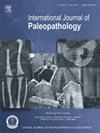常青藤和棕榈树:19世纪西班牙马德里埋葬的一个孩子的关怀和哀悼
IF 1.5
3区 地球科学
Q3 PALEONTOLOGY
引用次数: 0
摘要
目的评价19世纪中期儿童葬礼的关怀和象征意义。材料:木乃伊化的人类遗骸、医用绷带、残留的植物和衣物。方法牙科x线摄影,扫描电镜,植物鉴定,服装描述,回顾丧葬肖像。结果牙龄在5.5 ~ 6.5岁之间,性别为女性。左臂上的绷带包含一个由铜和锌组成的金属板和一片常春藤叶子(Hedera属)。棺材里放着一根棕榈枝,尸体穿着蓝色的衣服。绷带结合了传统知识(海德拉叶)和当代医学文献(金属板)的建议,代表了19世纪中期马德里一个儿童的护理案例。蓝色的衣服和编织的棕榈枝代表了基督教对她的死亡的哀悼。对随葬品和骨骼遗骸进行评估,可以让我们深入了解到,传统的医学治疗和当前的宗教象征是如何交织在一起的,以提供照顾和哀悼一个19世纪的孩子。限制:由于对保存的担忧和重新埋葬的时间限制,阻碍了对遗存的完整研究,而常春藤叶(可育)的类型限制了在物种水平上的鉴定。对进一步研究的建议:植物在近现代早期丧葬和古病理记录中的应用综述。本文章由计算机程序翻译,如有差异,请以英文原文为准。
The ivy and the palm: Care and mourning for a child buried in 19th-century Madrid, Spain
Objective
To evaluate indicators of care and symbolism in a mid-19th-century child burial.
Materials
Mummified human remains, a medical bandage, remnants of plants and clothing.
Methods
Dental radiography, scanning electron microscopy, botanical identification, clothing description, a review of funerary iconography.
Results
A dental age between 5.5 and 6.5 years and a female sex were estimated. The bandage on the left arm contained a metal plate composed of copper and zinc, and an ivy leaf (genus Hedera). A palm branch (Phoenix dactylifera) was placed in the coffin, and the corpse was dressed in blue clothing.
Conclusions
The bandage combines traditional knowledge (Hedera leaf) and contemporaneous recommendations from medical texts (metal plate) and represents a case of care of a child in mid-19th-century Madrid. The blue clothing and braided palm branch represent a Christian codified mourning for her death.
Significance
Evaluating funerary objects alongside skeletal remains has provided insight into ways in which traditional medical treatment, alongside current religious symbolism was intertwined to provide care and to mourn for a 19th-century child.
Limitations
Preservation concerns and time constraints due to reburial precluded a complete study of the remains, and the type of ivy leaf (fertile) limits identification at the species level.
Suggestions for further research
A review of plant use in the funerary and paleopathological record during the Early Modern Period.
求助全文
通过发布文献求助,成功后即可免费获取论文全文。
去求助
来源期刊

International Journal of Paleopathology
PALEONTOLOGY-PATHOLOGY
CiteScore
2.90
自引率
25.00%
发文量
43
期刊介绍:
Paleopathology is the study and application of methods and techniques for investigating diseases and related conditions from skeletal and soft tissue remains. The International Journal of Paleopathology (IJPP) will publish original and significant articles on human and animal (including hominids) disease, based upon the study of physical remains, including osseous, dental, and preserved soft tissues at a range of methodological levels, from direct observation to molecular, chemical, histological and radiographic analysis. Discussion of ways in which these methods can be applied to the reconstruction of health, disease and life histories in the past is central to the discipline, so the journal would also encourage papers covering interpretive and theoretical issues, and those that place the study of disease at the centre of a bioarchaeological or biocultural approach. Papers dealing with historical evidence relating to disease in the past (rather than history of medicine) will also be published. The journal will also accept significant studies that applied previously developed techniques to new materials, setting the research in the context of current debates on past human and animal health.
 求助内容:
求助内容: 应助结果提醒方式:
应助结果提醒方式:


